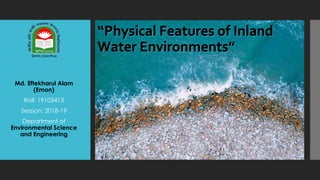
Physical Features of inland Water Environment.pdf
- 1. Md. Eftekharul Alam (Emon) Roll: 19103413 Session: 2018-19 Department of Environmental Science and Engineering
- 2. Introduction ❑ Inland Water: Water of the interior that does not border upon marginal or high seas or is above the rise and fall of the tides. The study of inland water is also known as Limnology. Rivers, streams, reservoir, wetlands, lakes( both freshwater and saline), and groundwater. ❑ Freshwater Environment: ► Pond ► Swamp ► River ► Lake ► Marsh ► Bog ► Fen
- 3. Physical Characteristics ❑ Characteristics would differ depending on the type of the water body ❑ Physical properties of water in any aquatic system are largely regulated by the existing meteorological conditions and chemical properties. ❑ The study of Freshwater ecology are divided into two groups: ► Lentic systems are diverse, ranging from a small, temporary rainwater pool a few inches deep to Lake. ► Lotic is nothing but the running water series are included all forms of inland waters in which the entire water moves continuously in a definite direction.
- 4. Density, Viscosity and Surface Film ❑ Density: Density of water varies inversely proportional to temperature. Water is most dense at 4°C and become less dense as its above and below. Salts dissolved in water directly increased its density. Density of most inland water bodies in much less than that of the ocean. ❑ Viscosity: Viscosity of water increases as density increases. It doubles as temperature decreases from 25°C to 0°C. It effects on movements of microscopic plants, animals, and sinking of particles in lakes ❑ Surface Film: When water is exposed to air, it acts like an extremely thin elastic, surface membrane. This is also known as Surface Film. Surface tension is maximum in pure water than in any other liquid except mercury. Surface film provides support for organisms
- 5. Surface Tension, Surface Radiation, Turbidity ❑ Surface Tension : Surface tension is responsible for the ability of some solid objects to float on the surface of a liquid. As temperature increases, molecules of water become more active and they move more rapidly; therefore, the intermolecular forces are more instable. Surface tension decreases with increasing temperature. ❑ Surface Radiation : Solar radiation heats the surface layers of water in lakes, reservoirs, and ponds more quickly than it warms deeper water. Water bodies often experience thermal stratification in which warmer, lighter water of the surface layer does mix with cooler, heavier deeper water ❑ Turbidity : Suspended material in water produces turbidity and reduces light penetration. Turbidity when caused by clay and silt particles in often important as a limiting factor and it is diversely proportional to the photosynthesis of aquatic phytoplankton and submerged macrophysics, not only retards the photosynthetic rate but clogs the gill systems of lamellibranches thereby increasing the rate of mortality
- 6. Effect of Light on Organisms ❑ Light plays an important role in lake ecology and determines the potential rate of photosynthesis ❑ The daily alternation of light and darkness establishes a rhythm in the activities of many aquatic organisms. Light is essential for photosynthesis. Some fish require light to feed ❑ Many organisms orient to light and some are sensitive to UV light. Small, soft bodied bottom dwelling organisms are particularly sensitive to light. It is thought the evolution of pigmentation, chitinous exoskeleton, shells, cases and similar other structure have helped certain photo sensitive species to survive in shallow, well lighted area
- 7. Effect of Temperature on Organisms ❑ Temperature changes produce characteristic patterns of circulation which greatly influence the aquatic life. ❑ Temperature variation in a fresh water habitat is smaller and the changes takes place very slowly this is due to unique thermal properties of water i.e. ❑ During the hot months of summer, the organism from the top layer migrate to the lower layers to avoid high temperature of epilimnion. With the onset of winter, as the surface water cool below the 4°C, it expands and become lighter, remain on the surface and freezes. Immediately below the ice, the temperature of water is very close to 0°C but further below of one / two meters it usually raises rapidly to 4°C.
- 8. Thermal Stratification ❑ In tropical lake, heat intake at the surface to the formation of a vertical temperature gradient within which the thermal resistance become too great for the existing winds to continue mixing the whole water masses. The upper warmer layer is called epilimnion and the lower cooler layer is called hypolimnion. In between the two distinct portions, a layer called thermocline
- 9. Thermal Circulation ❑ The inland water layers undergoes stratification in the summer and complete overturn in the autumn and spring. During winter, surface ice prevents further mixing by the wind. Small differences in density and temperature exist, with cooler water (0 °C [32 °F]) staying near the surface and warmer, denser water (4 °C [39.2 °F]) extending to the bottom.
- 10. THE END
